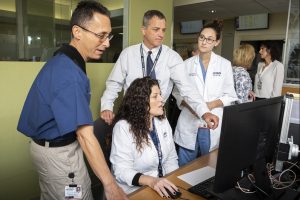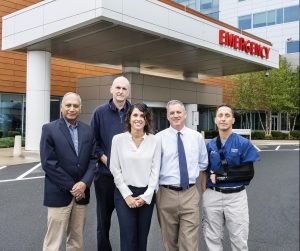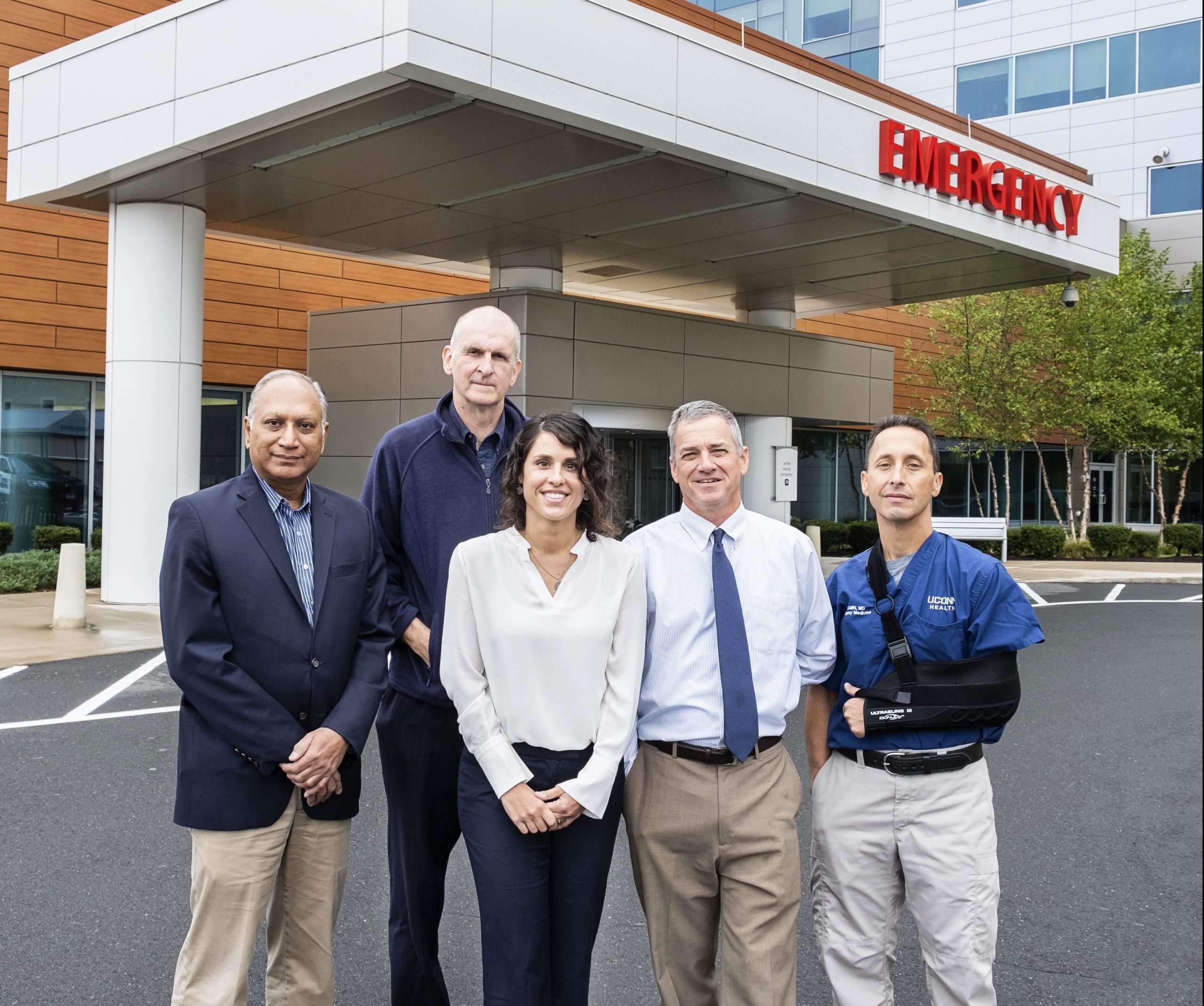When the Emergency Department (ED) at John Dempsey Hospital’s new hospital tower opened in 2016, it significantly transformed the patient care experience, raising the bar to an even higher level. Thanks to a thoughtful redesign aimed at providing the most expeditious and effective care possible, patients who arrive at UConn Health’s ED in serious condition – or who present with potentially life-threatening symptoms – are even more likely to walk out of the hospital with no lasting ill effects.
The new ED includes more than 40 private patient rooms and five patient-care zones, sorted by care for everything from minor emergencies to advanced trauma – along with specialized care teams poised to begin providing advanced medical care at a moment’s notice.
For patients exhibiting symptoms of heart attack or stroke, where every minute counts, that state-of-the-art expertise could not be more critical, since the danger of death or permanent disability is very real if a heart attack or stroke patient is not treated in time.
Thankfully, the care provided by the UConn ED team begins even before the patient arrives at the hospital, says EMS Coordinator Peter Canning, an RN and paramedic.
“UConn Health’s care really starts when the paramedic arrives at the patient’s side,” he says. “For instance, if somebody’s having chest pain, the paramedics put on a 12-lead EKG and if it shows a certain tracing, they can recognize that it’s a possible ST-Elevation Myocardial Infarction, or STEMI, a very serious type of heart attack in which a major artery in the patient’s heart is blocked.”
The paramedics call from wherever the patient is located to send a STEMI alert to the ED team, and transfer the patient’s electrocardiogram, or EKG, reading. Then an emergency medicine physician leader comes on the line and the paramedic describes what’s going on.
All of this takes place with clockwork precision.
“The physician will activate the cardiac cath lab while the patient’s still in their house,” Canning explains. “While the patient receives care on the way to the hospital, all of the mechanisms here are being put into place so that our Calhoun Cardiology Center’s cardiac interventionalist is on hand by the time the patient arrives. The end result is that we save heart muscle. The patient’s artery gets opened up much more quickly. We do a similar thing with stroke.”
UConn Health’s Medical Director of Emergency Medicine Dr. Alise Frallicciardi says a STEMI or stroke alert sets off a chain reaction, quickly pulling all members of the team together to deal with the incoming emergency. And whether the patient arrives by ambulance or comes to the ED on their own, “our doctors and staff are amazing at identifying that stroke, or that heart attack, or any condition that is bothering you. Our door-to-balloon time for heart attack care is quite low. We’ll have a doctor at your bedside quickly, so I think that’s a huge draw when people are [deciding where to go for their care]. We have doctors to see all of those patients quite rapidly, and we also have all of the resources of the stroke team and our cardiology team at our disposal. We rapidly triage our patients for care and try to keep our waiting room empty.”

Canning notes that in addition to its ED, which is open around the clock, UConn Health has seven satellite care locations, including two urgent cares – one in Canton and one in Storrs. “For example, at UConn Health Canton, in addition to primary and specialty care, we have a great walk-in urgent care clinic. People have had situations where they’re experiencing symptoms that could be consistent with a heart attack but are not sure if those symptoms are serious. They might think, ‘I’m not feeling so well. I’m a little nauseous,’ and they’ll go to urgent care,” he says.
“Our medical staff there will assess them, and if they do an EKG and realize that this person is having a STEMI, they’ll call 911 for an ambulance to transport the patient, then they’ll call the ED and send over the EKG results, so the cath lab is ready even before the ambulance arrives. And the person walks out of the hospital two days later with no major heart damage.”
Dr. Frallicciardi explains that UConn’s urgent care facilities actually function as part the health center’s ED. “All of us work out of the urgent cares as well, so when you go to one of our urgent care centers, there is a direct link. No matter what illness you have, if it requires a higher level of care, if the patient needs an emergency room, the urgent care will call us to help care for you as quickly as possible.”
Stroke Program Director Dr. Sanjay Mittal says in order to achieve the best possible outcome for each patient, the medical team at UConn Health’s ED makes the most of every minute, from the second the patient arrives. “We closely monitor the time, from when the patient was brought in, to the time the patient received care or clot-busting medications,” he says. “Our best timing, a couple of weeks ago, was 16 minutes. We are all coming to a point where we’re able to deliver care in the fastest way possible, and the safest way possible. I think one reason for that is that we are in an academic medical center. We use the latest available medical knowledge and technology, and personalize each patient’s care, and take care of the patient in a very comprehensive, effective manner.”
Emergency Medicine Department Chair and Chief of Service Dr. Robert Fuller says in situations where the patient’s health or life is at risk, effective teamwork is essential. “When somebody comes into the ED very sick, they need the support of the entire UConn Health academic medical center system – that extends beyond what I can do alone. I need experts like Dr. Sanjay Mittal, director of our stroke program. I need experts like the neurosurgeons led by Dr. Ketan Bulsara. I need my cardiologists, providers in the ICUs, nurses, etc., to provide really skilled, specialized care so that, ultimately, patients can leave this place walking out intact with the best possible outcomes and able to have the best quality of life.”
Dr. Fuller adds, “Our objective is to get patients the intervention they need in the most efficient and easiest way possible.”
That also relies on optimal access to the tools and resources needed to expedite care. UConn Health’s Emergency Medicine Physician Leader, Dr. Richard Kamin, says the department’s new design includes a CT scanner and an x-ray suite within the ED. As a result, “our patients don’t have to be moved to another part of the hospital. They stay safely within arm’s reach of the critical care and emergency medicine staff while the specialists are collaborating to take care of the patient,” he says.

“For example, you have to do a CT scan to help decide whether or not it’s appropriate to give clot-busting medicine to a stroke patient. When the EMS providers call us from the field, we actually put a hold on the CT scanner. The neurologist meets us, and they walk with us to the CT scanner. We go right to the scan table to help the neurologist decide, in conjunction with the exam, whether this patient should receive that medicine, so we’re doing a lot in that short window of time.”
Just importantly, all members of the ED team know exactly what to do when a patient suffers a medical crisis, like a stroke.
“When our stroke center team reaches the ED, we always have our nurses and doctors there, immediately taking care of the ABCs – airway, breathing, and circulation, along with vitals. Diagnostic imaging tests and clot-busting medications have to be delivered rapidly to save a patient’s life or prevent permanent injury deficits to their brain and body’s mobility,” Dr. Mittal says.
“Stroke happens because there is a clot in the brain, and when there is a clot in the brain, a certain part of the brain will stop receiving blood.
Blood carries oxygen. If your brain does not get oxygen for more than three minutes, those brain cells start to die. The faster we remove the clot, or bust the clot, the higher the chances are of a meaningful recovery. By the time the patient comes to us, they have already been experiencing their symptoms for some time, so the providers get a really short window in which to capture all of the history, and the physical and patient details, and deliver clot-busting medications.”
He says in order to respond in an optimal way, “Stroke care in our ED is heavily protocol-driven, and the protocol demands many people all at once by the patient’s side, because the labs have to be drawn; the nurses do the initial evaluation; the physicians also are there. We all have to interface with the ED physicians and the EMS, and the whole thing has cascaded through a process called ‘stroke alert.’ ”
Dr. Fuller notes that while time is of the essence when treating a stroke, a person experiencing one typically doesn’t feel any pain, “so patients might let the clock tick for a while” before seeking medical care. “Pain brings people to the ED very quickly. With a stroke, you might not be as motivated to come in, so we lose time because patients aren’t aware of the signs and symptoms of stroke and may not know that they should come to the ED very quickly.”
Fortunately, says Dr. Kamin, when a patient does arrive at the ED with a clinical suspicion for stroke, “there is an opportunity to have expeditious imaging that tells us exactly where that clot is and whether or not this patient is an appropriate candidate to have medicine to clear it, or even needs an urgent, lifesaving interventional procedure, with our experienced neurosurgery team, to surgically remove the clot from their brain. And, if so, we activate the neurosurgeons quickly who do this brain surgery intervention. The patient is then taken swiftly to our high-tech, specialized hybrid operating room at UConn’s John Dempsey Hospital.”
Dr. Mittal says in addition to three neurologists who provide full neurological coverage 24/7, the ED team has all of the cutting-edge technology and expertise to deal with virtually any situation. “It could be the patient has such a big stroke that the brain has swollen and needs surgery. We can do that here, but more importantly, just like in the heart cases, we can use a wire that goes in and opens up the arteries, through a fairly new process called a thrombectomy,” he explains. “Nowadays, our surgeons can actually put in a wire through the groin and get to the clot, deliver a little bit of clot-busting medication at that point, and open that artery.”
In fact, UConn Health is one of only three hospitals in the state with the expertise to perform these mechanical thrombectomies, “which means that by coming to us first, you don’t have to be transferred to another hospital. We provide comprehensive stroke care.”
He notes that stroke treatment does not end with delivering clot-busting medication or surgery, and treatment for a heart attack does not end when the immediate crisis is over. To increase the chances of a complete recovery, these conditions also require in-depth follow-up care, including physical therapy. And all of the post-ED treatment that is required by a stroke or heart attack patient can be accessed through UConn Health, making it a one-stop shop for care.







More Stories
Jamie Shawver, D.O.: The Modern-Day Family Doctor
Leading in Urologic Oncology: Ryan Dorin, M.D., Works on Expanding Patient Care
UConn Health Stands at the Forefront of Comprehensive Sickle Cell Treatment in the U.S.